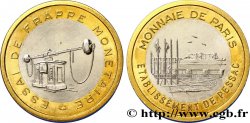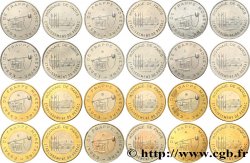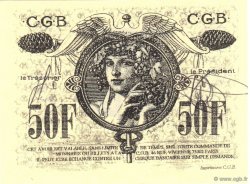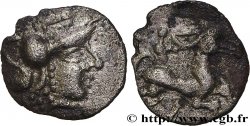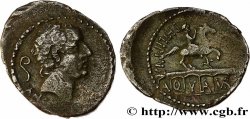Live auction - feu_369456 - EUROPEAN CENTRAL BANK Série complète Training tokens - 1 cent à 2 Euro n.d. Pessac
You must signin and be an approved bidder to bid, LOGIN TO BID. Accounts are subject to approval and the approval process takes place within 48 hours. Do not wait until the day a sale closes to register. Clicking on "BID" constitutes acceptance of the terms of use of cgb.fr private live auctions.
Bids must be placed in whole Euro amounts only. The sale will start closing at the time stated on the item description; any bids received at the site after the closing time will not be executed. Transmission times may vary and bids could be rejected if you wait until the last second. For further information check the Live auction FAQ
All winning bids are subject to a 18% buyer’s fee.
All winning bids are subject to a 18% buyer’s fee.
| Estimate : | 1 800 € |
| Price : | no bid |
| Maximum bid : | no bid |
| End of the sale : | 15 December 2015 18:30:30 |
Type : Série complète Training tokens - 1 cent à 2 Euro
Date: n.d.
Mint name / Town : Pessac
Quantity minted : ---
Orientation dies : 12 h.
Rarity : R3
Catalogue references :
Obverse
Obverse legend : TRAINING TOKEN.
Obverse description : inscription “TRAINING TOKEN” - poinçon double corne dans l’ovale.
Reverse
Reverse legend : VALEUR FACIALE.
Reverse description : Carte simplifiée de l’Europe.
Commentary
Lot de 8 Training token (1 cent, 2 cent, 5 cent, 10 cent, 20 cent, 50 cent, 1 Euro et 2 Euro). Les training token, “jetons d’entraînement” furent fabriqués par la Monnaie de Paris à la demande de la Commission Européenne. La Commission Européenne adressa ces séries de monnaies “test” à des organismes s’occupant de personnes aveugles, sourdes et handicapées mentales, dans le but de les aider à se familiariser avec le maniement de la monnaie Euro.
Prêtés pour une durée de quelques mois, les training token furent récupérés en quasi-totalité puis détruits. Les organismes ne les restituant pas, étaient soumis à de fortes pénalités financières.
Fabriqués à 37.000 exemplaires, ils furent frappés entre le 18 novembre 1998 (date de modification technique des 10 cent et 50 cent) et le 8 Mai 2001 (date de distribution de ces pièces).
Certaines caractéristiques diffèrent des pièces Euro actuelles (diamètre, poids, gravure etc.), alors que d’autres sont semblables (bi-métallique, tranche...).
Caractéristiques des 8 training token du lot:
- 1 cent, frappe médaille, tranche lisse, poids 2,52g., non magnétique
- 2 cent, frappe médaille, tranche lisse avec une rayure circulaire, poids 3,24g., non magnétique
- 5 cent, frappe médaille, tranche lisse, poids 4,18g., non magnétique
- 10 cent, frappe médaille, tranche avec larges cannelures, poids 4,17g., non magnétique
- 20 cent, frappe médaille, tranche lisse avec sept cannelures profondes, poids 5,96g., non magnétique
- 50 cent, frappe médaille, tranche avec larges cannelures, poids 8,05g., non magnétique
- 1 Euro, frappe médaille, bi-métallique, tranche alternée lisse et cannelée (3 séries de stries fines), poids 7,43g., non magnétique
- 2 Euro, frappe médaille, bi-métallique, tranche avec stries fines, poids 8,26g., non magnétique
Tout l’historique des training token est détaillé dans un article du Bulletin Numismatique, n° 48, pages 25-26.
Lot of 8 Training tokens (1 cent, 2 cent, 5 cent, 10 cent, 20 cent, 50 cent, 1 Euro and 2 Euro). The training tokens were manufactured by the Monnaie de Paris at the request of the European Commission.. The European Commission sent these series of \\\"test\\\" coins to organizations working with blind, deaf and mentally handicapped people, with the aim of helping them become familiar with handling the Euro coin..
Loaned for a period of several months, the training tokens were almost entirely recovered and then destroyed.. Organizations that did not return them were subject to heavy financial penalties..
Made in 37. 000 examples, they were struck between November 18, 1998 (date of technical modification of the 10 cent and 50 cent) and May 8, 2001 (date of distribution of these coins).
Some characteristics differ from current Euro coins (diameter, weight, engraving etc.). ), while others are similar (bi-metallic, slice. . . ).
Characteristics of the 8 training tokens in the set: - 1 cent, medal strike, smooth edge, weight 2.52g. , non-magnetic - 2 cent, medal strike, smooth edge with a circular stripe, weight 3.24g. , non-magnetic - 5 cent, medal strike, smooth edge, weight 4.18g. , non-magnetic - 10 cent, medal strike, edge with wide grooves, weight 4.17g. , non-magnetic - 20 cent, medal strike, smooth edge with seven deep grooves, weight 5.96g. , non-magnetic - 50 cent, medal strike, edge with wide grooves, weight 8.05g. , non-magnetic - 1 Euro, medal strike, bi-metallic, alternating smooth and fluted edge (3 series of fine grooves), weight 7.43g. , non-magnetic - 2 Euro, medal strike, bi-metallic, edge with fine grooves, weight 8.26g. , non-magnetic The entire history of training tokens is detailed in an article in the Bulletin Numismatique, n° 48, pages 25-26
Prêtés pour une durée de quelques mois, les training token furent récupérés en quasi-totalité puis détruits. Les organismes ne les restituant pas, étaient soumis à de fortes pénalités financières.
Fabriqués à 37.000 exemplaires, ils furent frappés entre le 18 novembre 1998 (date de modification technique des 10 cent et 50 cent) et le 8 Mai 2001 (date de distribution de ces pièces).
Certaines caractéristiques diffèrent des pièces Euro actuelles (diamètre, poids, gravure etc.), alors que d’autres sont semblables (bi-métallique, tranche...).
Caractéristiques des 8 training token du lot:
- 1 cent, frappe médaille, tranche lisse, poids 2,52g., non magnétique
- 2 cent, frappe médaille, tranche lisse avec une rayure circulaire, poids 3,24g., non magnétique
- 5 cent, frappe médaille, tranche lisse, poids 4,18g., non magnétique
- 10 cent, frappe médaille, tranche avec larges cannelures, poids 4,17g., non magnétique
- 20 cent, frappe médaille, tranche lisse avec sept cannelures profondes, poids 5,96g., non magnétique
- 50 cent, frappe médaille, tranche avec larges cannelures, poids 8,05g., non magnétique
- 1 Euro, frappe médaille, bi-métallique, tranche alternée lisse et cannelée (3 séries de stries fines), poids 7,43g., non magnétique
- 2 Euro, frappe médaille, bi-métallique, tranche avec stries fines, poids 8,26g., non magnétique
Tout l’historique des training token est détaillé dans un article du Bulletin Numismatique, n° 48, pages 25-26.
Lot of 8 Training tokens (1 cent, 2 cent, 5 cent, 10 cent, 20 cent, 50 cent, 1 Euro and 2 Euro). The training tokens were manufactured by the Monnaie de Paris at the request of the European Commission.. The European Commission sent these series of \\\"test\\\" coins to organizations working with blind, deaf and mentally handicapped people, with the aim of helping them become familiar with handling the Euro coin..
Loaned for a period of several months, the training tokens were almost entirely recovered and then destroyed.. Organizations that did not return them were subject to heavy financial penalties..
Made in 37. 000 examples, they were struck between November 18, 1998 (date of technical modification of the 10 cent and 50 cent) and May 8, 2001 (date of distribution of these coins).
Some characteristics differ from current Euro coins (diameter, weight, engraving etc.). ), while others are similar (bi-metallic, slice. . . ).
Characteristics of the 8 training tokens in the set: - 1 cent, medal strike, smooth edge, weight 2.52g. , non-magnetic - 2 cent, medal strike, smooth edge with a circular stripe, weight 3.24g. , non-magnetic - 5 cent, medal strike, smooth edge, weight 4.18g. , non-magnetic - 10 cent, medal strike, edge with wide grooves, weight 4.17g. , non-magnetic - 20 cent, medal strike, smooth edge with seven deep grooves, weight 5.96g. , non-magnetic - 50 cent, medal strike, edge with wide grooves, weight 8.05g. , non-magnetic - 1 Euro, medal strike, bi-metallic, alternating smooth and fluted edge (3 series of fine grooves), weight 7.43g. , non-magnetic - 2 Euro, medal strike, bi-metallic, edge with fine grooves, weight 8.26g. , non-magnetic The entire history of training tokens is detailed in an article in the Bulletin Numismatique, n° 48, pages 25-26







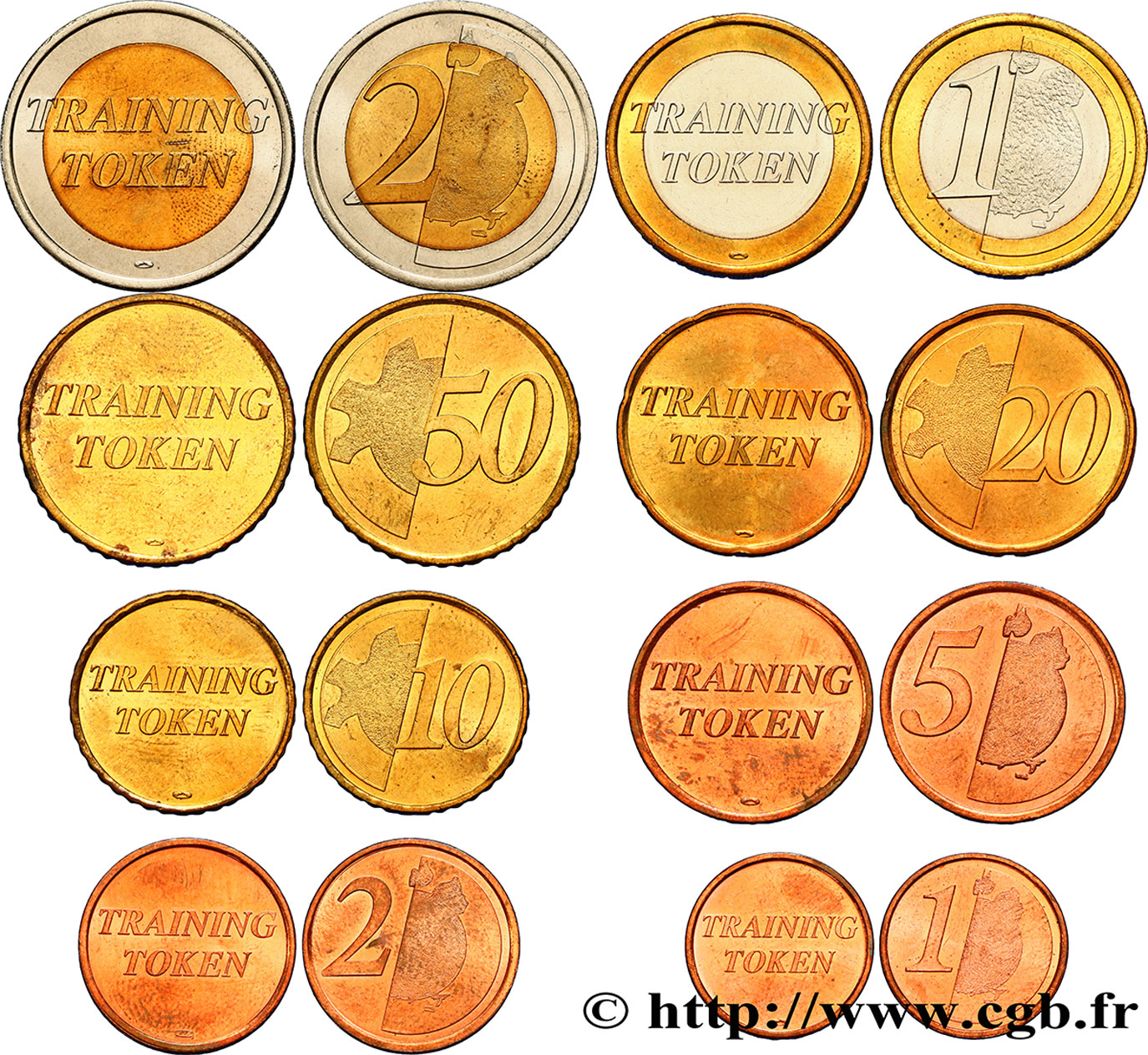
 Report a mistake
Report a mistake Print the page
Print the page Share my selection
Share my selection Ask a question
Ask a question Consign / sell
Consign / sell
 Full data
Full data


